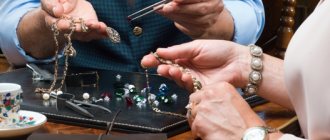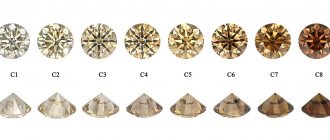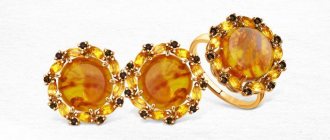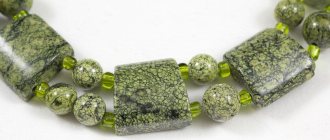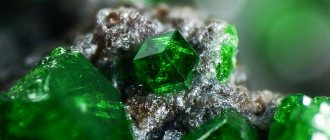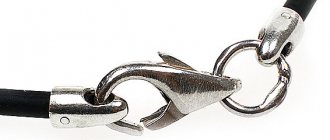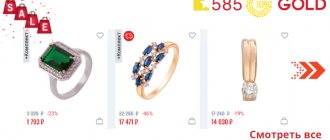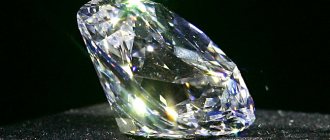Where are diamonds sold?
A prestigious place for selling stones is auctions like Sotheby's. But only the best diamonds are sold here.
Ordinary consumers choose from the following options:
- specialized salon or online store;
- representative .
If you are accustomed to shopping in online stores, it is advisable to choose diamonds from two or three. View the range, read reviews.
The level of the usual salon (offline) is indicated by the conditions created for the buyer:
- There is a place where you can calmly, without prying eyes, evaluate a stone before purchasing. Including using special tools: 10x magnifying glass, carat scales, etc.
- The client is not required to know how to use these devices. At his request, a sales consultant or in-house jeweler will do this. Education and qualifications of personnel will be a plus.
- There are tables with a breakdown of the main characteristics of the stone.
Buying second hand is possible if you are confident in the person’s honesty. But a stone certificate is required.
How to distinguish a real diamond from a fake?
Due to the fact that diamonds are of particular value and have always been expensive, there are a large number of fakes on the market. Therefore, do not even try to delve into the specifics of the definition of a stone. It is simply impossible to identify a diamond by “eye” or “tooth”. When purchasing an unmounted diamond, the seller must issue a certificate of conformity and authenticity of the diamond for each stone, confirmed by an independent authoritative laboratory, which will indicate its number, parameters and proportions, as well as reliably provide information about the symmetry and quality of polishing of this stone. An unmounted diamond must be packed in a blister, where the number of the certificate of conformity is indicated, and it is opened directly by the buyer.
The most valuable and authoritative confirmation of the quality of a diamond is the GIA certificate. This is a kind of passport for the stone, which confirms its authenticity.
GIA Certificate
Another win-win option for buying a real diamond is a simple rule: choose a reliable seller. There are many large companies that have been selling both loose diamonds and diamond jewelry for many years. Choose reliable sellers who sell diamonds without settings or jewelry with diamonds, and then the quality of the stones will not raise any doubts.
Understanding diamonds at a professional level is very difficult, but each of you will be able to master this topic enough to buy a diamond without a setting or jewelry with a high-quality gemstone and not be mistaken. And in this article, I explained in detail how to understand diamonds even if you are a beginner.
Who issues certificates
A certificate of conformity is drawn up for each pebble. The official name is the Gemological Examination Act. Issued by gemological organizations or processors.
Number one on the list is the Gemological Institute of America (GIA). The GIA certificate is recognized by everyone. For example, the Israeli Diamond Exchange only works with it.
In the Russian Federation this is the Gemological Center at Moscow State University.
The document contains information about the main qualities of the stone: place of extraction and processing, carat weight, color, clarity, type of cut, fluorescence. Defects are described (quantity and nature).
The certificate number is stamped on a pebble, usually on a girdle (belt), and can be read under a magnifying glass.
Choosing a diamond using the “4 C” system
Does everyone know that a diamond is a cut diamond, inconspicuous in appearance? Not every diamond has all the cutting properties. It is a mistake to believe that the main thing in a gemstone is its size.
The quality of all diamonds is determined according to an international system called the “4 Cs”:
- cut – cut;
- clarity – purity;
- color – color;
- carat – weight.
Characteristics of diamonds
Professional stone evaluation is based on the 4C system. It is suggested to choose a diamond, taking into account weight, processing, clarity, color. Weight
The first thing people talk about when mentioning diamonds is weight.
The following categories of stones are distinguished (in carats):
- up to 0.291 – small;
- up to 0.991 – average;
- from 1,000 – large.
Popular options are from 0.300 to 0.990 carats.
Almost carat specimens are good as a ring or a ring; smaller ones can be used as earrings or as a set (for a brooch, necklace).
If you want to have a large stone, experts advise paying attention to specimens of 0.990 carats: they visually copy one-carat stones, but are much cheaper.
Cut
The cut is considered a very important characteristic; only after it does the diamond become a diamond:
- More often this is the classic version - a circle with 57 faces (KR57). Used for specimens larger than 0.300 carats.
- On smaller crystals, an indicator of 17 is acceptable.
- Large expensive stones have from 74 to 102 facets.
- Depending on the shape of the crystal, fancy options are used: heart, pear, “Marquis”.
Diamond craftsmanship is an art. There are the following cut levels: A, B, C, D, where A is the highest.
Purity
The international scale provides 11 levels of purity: from IF (ideal) to I3 (defective).
Russian classification: nine purity groups for small stones, 12 for the rest. Crystals of ideal transparency are assigned 1, if inclusions are noticeable and numerous - 12.
Crystals up to the seventh level inclusive are considered a good choice in terms of purity.
Instances of levels 8–12 are best avoided. They are unattractive and can crack due to numerous internal cracks. We wrote more about diamond clarity and color here.
Color
A diamond is considered to be transparent and colorless. But there are also colored copies.
White (colorless)
The ideal color of a diamond is white. In practice, most crystals with a yellowish tint:
- Absolutely white (according to all classifications - 1) are rare and expensive.
- Colorless stones in Russia are divided into nine groups. The ninth are specimens with visible yellowness or brownishness.
- International classification is letter, from D to Z.
- The best-selling stones in Russia are those with indicators from 3rd to 5th inclusive. Europeans prefer colors 4 and 5 (J and H).
It is impossible to visually determine the difference between the third-fourth or fourth-fifth levels. And the cost of a gem varies, so the choice of diamond is made consciously to avoid overpayments.
We recommend that you read: how to determine the authenticity of a diamond at home.
Colored diamonds
Their cost is determined by color assessment: brightness and saturation. Colored stones are cheaper than colorless ones. But “fancy” ones are several times more expensive than colorless ones.
Fluorescence reduces the price of the stone by 15–35%.
Various shapes.
The easiest way to determine the cut is to look at the shape of the diamond and then examine its facets. The most common diamond cuts:
— Round
It is easily recognized and is the most popular shape found in any jewelry store that sells diamonds. This cut has 57 or 58 facets and is designed to maximize the brilliance of the diamond.
— Oval
The oval cut is also easy to recognize because of its shape. If the ratio of length to width is small, then it will look like a round one.
"Marquis" is a type of oval. These diamonds have an oval profile, but have two sharp corners.
The pear cut is also oval in shape, but it has one sharp corner. The heart cut is similar to a pear, but has a notch opposite the sharp corner, which gives the stone the appearance that matches its name.
Rectangular
Rectangular cuts, as the name suggests, have a rectangular or square cross-section.
The princess cut is a typical rectangular cut, and its shape is usually square with four sharp corners.
"Radiant" is also a rectangular cut, but its four corners are not sharp, but truncated.
“Emerald” – also shaped like a rectangle with truncated corners. Its difference from the “radiant” is in the shape and arrangement of the edges.
The radiant cut has triangles and quadrangles, while the emerald cut has parallel sides and the facets are rectangles.
“Radiant” is a cross between “emerald” and “princess”. This cut allows the diamond to shine and sparkle.
“Asher” is reminiscent of emerald, with the only difference being that it has a square shape. Thus, it is a square emerald cut.
“Cushion” does not have a strictly rectangular shape. In cross-section, such a diamond resembles a rectangle, but its corners are not sharp and its shape is rounded. A cushion diamond resembles a pillow.
— Triangular
The "triangle" or "trilliant" cut is the most common triangular cut. It usually has sharp corners. But there are also triangles with more rounded corners.
What to consider when choosing a stone
The sparkling splendor of the showcase will easily make you lose your head. To prevent this from happening, you should only consider diamond products at affordable prices:
- Compare three to five copies of comparable quality and type.
- Choose a product with the best price-quality ratio.
- Analyze the certificate of authenticity. If it is not there, there is nothing to talk about. A document issued by a store is not a guarantee.
- Crystals with indicators of 1/1 (or similar) in purity and color should be chosen only as an independent object.
- Cheaper pieces are used for diamond jewelry: the setting will hide minor defects and visually change the shade.
A ring with a carat diamond is much more expensive than a similar one with several crystals of the same total mass.
Remember the tricks of manufacturers
Small stones with characteristics such as 5/5 will appear visually yellow, so they will be set in yellow gold to smooth out this effect. And if a large stone has characteristics of 5/5, then visually you will not notice any admixture of color and are unlikely to distinguish it from the same stone with characteristics of 3/3, unless you are an expert gemologist. This diamond will be framed in white gold. Knowing this, you can save some money.
In addition to the stone, you should pay attention to the weight of the entire piece of jewelry. Good manufacturers do not skimp on gold, so a high-quality ring weighs at least 2 g. The shank will be dense and not thin, which will allow the product to last much longer than lighter analogues that can bend or break in half. The weight of gold used will not greatly affect the price of the product, because the main part of the cost is the price of the diamond in dollars, the rest is the percentage of the retail outlet and the brand.
Based on this information, everyone can decide for themselves where they can save money, what to close their eyes to, and where to be more attentive. Buy the best wisely, diamonds are a great investment for years to come.
Diamonds for investment
Jewelry is desirable for ladies: they have status, a ring as a gift means a marriage proposal. Business people consider stones as an investment object.
A ring with a diamond
Investment specimens are considered to have the following characteristics:
- Weight – from 5.01 carats.
- Purity – from IF to VS2.
- Cut – KR57.
- Color ranges from D to F.
- Fluorescence is zero.
Such copies are the most profitable: even if they are resold, then with the least loss.
Astrologers claim that only fire signs of the Zodiac can handle a diamond. But today any self-confident, self-sufficient person can find an ally in him. We recommend watching the video instructions.
How to find out how many carats a diamond is?
The size of a diamond or other gemstone is the diameter when cut into a round shape. The most accurate ratio of the diameter and weight of a diamond in its standard cut is usually calculated in carats. Any expert can determine how many carats it contains without even measuring a stone. In other words, it is a unit of weight of a gemstone, which is 1/5 of a g. That is, 1 carat is equal to 0.2 g. But since most people buy diamonds once or more in their lives, it is not necessary to know these formulas. The approximate data of the stones can be measured in millimeters to imagine how it will look in reality (if you are viewing the stones remotely). There are entire tables for this, which in most cases determine the size most accurately. Experts evaluate the quality of diamonds and also compare them with other stones using the four parameters listed above. Therefore, when purchasing any stone, you should take into account not only its size, but also the data that we will provide in more detail below.
